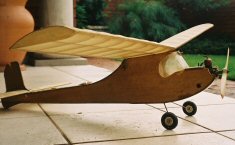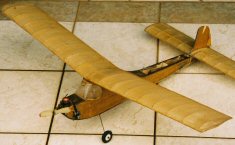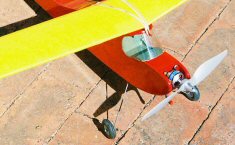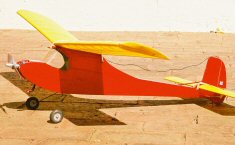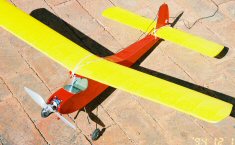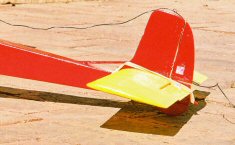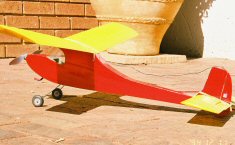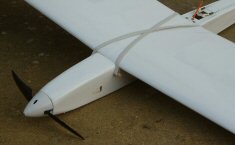|
|||
|
|
|
||
| View Shopping Cart |
| Home |
| Guides Available |
| About the Author |
| FAQs |
| Testimonials |
| Articles |
| Contact Andrew |
| Terms & Conditions |
| Mailing List |
| Links |
 |
 |
Get more great
articles like this one absolutely free with every
Gibbs Guides e-magazine. Join
the mailing list!
Veron Cardinal
Jock Cameron tells the story of his diesel to electric Veron Cardinal conversion
With comments and reply from Andrew Gibbs
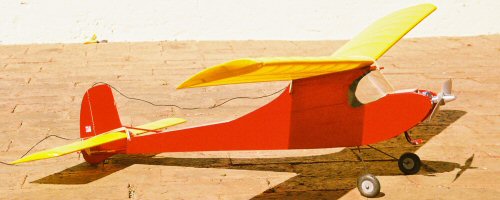
Hi Andrew, I bought this Veron Cardinal, probably about twenty five to thirty years ago in London, England. I then brought it back with me to Pretoria, South Africa and built it. You'll notice from the photo below that it was powered by a little McCoy 049 diesel and it flew very well as a sport free flight model. However, the African veldt certainly took its toll on the model, particularly the silk (wings and tailplane) and tissue (fuselage) covering when landing amongst the thorn bushes and Acacia trees. Needless to say the Cardinal also found the occasional rock in the long grass.
Thus while the model was very satisfying to fly, the flying field available to me for free flight was far from ideal, with the result that it didn’t have that many flights. Also I normally flew it when the winter late afternoon Highveld weather was virtually windless, limiting the distance I needed to run for retrieval. In short, flying the Cardinal was pleasant though somewhat onerous, considering the inevitable mainly minor repairs. Snakes too, were always a consideration in my mind, when running across the veldt after it.
| The Veron Cardinal before conversion (click small images to enlarge). | Before it was converted, the model had become quite shabby (click small images to enlarge). |
Then one day I came across your column. I followed your articles very closely for many months, gleaning an understanding of this, to me very new and mysterious art of electric flying. Terms like in-runners versus out-runners, together with in my mind, totally unintelligible power ratings with little (if any!!) comparison to IC motors, BECs, Li-Po versus nicad, ESC versus mechanical controllers; all had to be unraveled in my mind, which your articles were helping me enormously to come to grips with. This is why I photo-copied and filed your articles to read, re-read and refer to regularly. It is directly as a result of your writings which eventually encouraged me to try to electrify my old Veron Cardinal. You made it sound so possible for even me!
The Cardinal’s electric modification was carried out step by step referring very often to many of your articles and eventually the great day arrived when after doing all the checks and rechecks, I hand launched the model off a rugby field. I would like to say that it flew perfectly but in all honesty it didn’t! It was very sensitive to rudder but highly under powered – I used an SJ 2815M Korean outrunner motor advertised to operate on a 2S LiPo giving an rpm of 7,100 on an 8 x 4 electric prop at 3.7A. Although it crashed seconds after the hand launch I had time to see that the model and the total electric system had vast potential for me living on a golf course in a security estate, where noise would be a problem. The first thing I did was to repair the Cardinal, which again had no serious damage (and says much for this design!), as it had only managed to waffle to an altitude of about six feet. I then went out and bought a slightly larger out-runner - an E-flite 370 driving an 8 x 4 electric prop with a Ripmax 22Amp BEC ESC and a 2S LiPo.
I also programmed my JR transmitter with plenty of exponential on rudder, as I realized that the large amount of dihedral in the wings which is as per the Veron plan, was intended for free flight, not radio control. In electrifying the Cardinal I had only beefed up the wing by adding 1/16 center section sheeting and an added rear spar to accommodate the extra RC loads.
| The nose of the Cardinal houses an EFlite 370 outrunner. | After conversion and restoration, the model was completely transformed. |
My next attempt to fly the Cardinal was met with great success as it
now flew well, still very sensitive but fully controllable. It is covered
in yellow Litespan (wings and tailplane) and the fuselage and fin are
tissue covered and sprayed lightly with red Humbrol enamel. It has had
several flights now, using exclusively your information from the various
magazine articles you wrote and to date has not even suffered a minor
tissue tear! Very different to this model’s previous history and
at this rate I can see that my model could still be flying for many years
to come yet.
Here in Pretoria we are approximately 5,000 feet above above sea level
and please correct me if I’m wrong but I don’t believe this
has any significant effect on the electric motor power output, but probably
has a negative effect on prop and airframe efficiency.
Andrew thank you very much indeed for your step by step manner of getting me to this stage of electric flying and I look forward to many more of your highly informative articles written in such an easy to read style without becoming bogged down in vast and complicated technicalities. With the success in electric flying you have led me to, I am now in the process of repairing and modernizing my Goldberg Electra by doing away with the mechanical speed controller and separate very heavy nicads and brushed motor.
My intention is primarily and most importantly to say thanks to you for opening this door in my aeromodelling by way of your special gift to simplify an otherwise potentially very complex subject.
| The yellow and red makes for a pretty color scheme. | The Cardinal's tail surfaces. |
Andrew answers
Hello Jock, Very many thanks to you for taking the trouble to write, and
especially for your kind words. Model flying in South Africa sounds very
exciting, what with having to worry about snakes!
Your Cardinal is a charming design, and I am sure it looks marvelous in flight, wafting by quietly under control. Electric power conversions and radio control have given many such free flight designs a new lease of life.
You say your initial attempts to fly were with a motor drawing 3.7A on two Lipo cells. This equates to around 27 Watts (3.7Vx 7.4A). You also said your model weighs 391g (14 ounces, or 0.9 lbs). This would mean a power to weight ratio of around only 24 Watts per pound, which is definitely considered insufficient even for this type of model, hence the poor performance you experienced initially.
| The Cardinal from the rear. This is a handsome model from any angle. | My Goldberg Gentle Lady. |
Concerning your question about altitude - high altitude in itself will not affect your power system electrically, but there will be aerodynamic effects - the air is thinner at altitude, so the propeller will place less of a load on the motor than it would at sea level. It's always worth measuring the current drawn by the motor and prop, and if it's not enough, fitting a prop with a greater pitch and/or diameter may correct this.
Also, the model will have to fly a little faster through the air than it would do at sea level in order for the wings to develop the same lift. For this reason, you may need a little more power compared to sea level flying.
I also wish you luck converting your Goldberg Electra to modern Lipo and brushless power. You will be replacing heavy equipment with light stuff, and while this will make an excellent contribution to weight loss, you may find that it gives you a problem to obtain the correct CG. In extremis, you may have to lengthen the nose. Some years ago I converted a Gentle Lady to electric power, and I shortened the nose a little thinking this would be fine. However, even with using a heavy old brushed 540 motor in the nose I then struggled to bring the CG far enough forward. I even had to resort to using a closed loop system for the rudder to save the weight of a balsa pushrod! If I ever decide to convert this model to brushless Lipo power, I will have to build a new and much longer nose.
